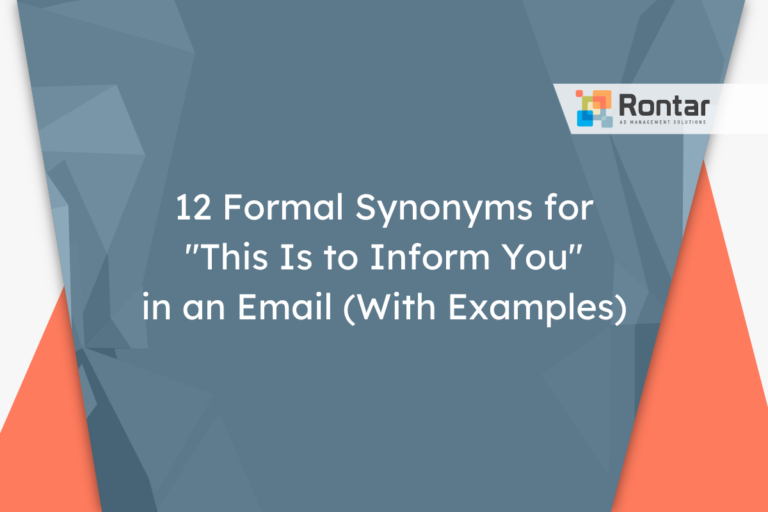10 Other Ways to Say “Dear”

How we start our emails can set the tone for the entire message. Often, we use “Dear” to begin, but it might feel too formal or outdated for some situations.
This article explores ten different ways to greet someone in a professional email, offering a mix of formal and informal alternatives. Each option is explained with examples, helping you choose the right word for your next email.
Is It Professional to Say “Dear”?
The use of “dear” in communication is often considered professional, formal, and polite. It’s particularly well-suited for formal letters, emails, and messages where maintaining a courteous and professional attitude is crucial. You should consider using “dear” in communications with business partners, clients, or any individual where a level of formality is required.
Email example:
Dear Mr. Thompson,
I'm writing to confirm our meeting scheduled for next Wednesday at 10 AM. Please let me know if this time still works for you.
Best regards,
Emily
Pros:
- Establishes a professional tone
- Widely recognized as polite and respectful
- Offers flexibility in formal and semi-formal communications
Cons:
- May feel overly formal in casual or close relationships
- Can be seen as outdated in rapidly evolving digital communication contexts
While “dear” is widely accepted, some people might look for synonyms or alternatives to use in less formal situations or when they want to convey a more contemporary tone.
10 Other Ways to Say “Dear”
When you’re looking to mix up how you address your professional emails, here are ten common alternatives that convey the same respectful tone as “dear” without being overly formal:
- Hi
- Hello
- Greetings
- Good Day
- Hey
- To [Name]
- Good Morning/Afternoon/Evening
- Welcome
- Attention [Name or Team]
- Esteemed [Title/Name]
1. Hi
This alternative is less formal than “dear” but remains polite and professional in tone. It’s a warm way to start an email and sets a friendly, approachable tone right from the beginning. “Hi” works well in most professional settings, especially when you have an established relationship with the recipient.
This synonym is better used with colleagues you interact with regularly or clients you have a more casual relationship with. It’s suitable for emails and instant messages within most professional contexts.
Example:
Hi Mark,
Thank you for sending over the report. I will review it and get back to you shortly.
Best,
Lisa
2. Hello
“Hello” is another polite and universally understood greeting that’s a step more formal than “hi” but still feels welcoming. It’s one of the most versatile synonyms for “dear” and can safely be used in nearly all professional correspondence.
This greeting is particularly effective when you’re not sure about the level of formality required. It fits well in both emails and letters, to colleagues, clients, or even higher management.
Example:
Hello Dr. Harris,
I'm looking forward to our meeting next week. Please find attached the agenda for your review.
Regards,
Emily
3. Greetings
Using “Greetings” as an alternative to “dear” introduces a message with a formal yet warm tone. It’s less commonly used, making it stand out in professional emails and letters. This option strikes a balance between traditional formality and a touch of personal warmth.
This option is best suited for initial communications with new clients, formal business proposals, or messages intended for an audience you haven’t interacted with much before. It’s more commonly used in emails than in instant messaging.
Example:
Greetings,
We are thrilled to introduce our new product line, which we believe will be of great interest to you.
Sincerely,
The Team at Innovations Inc.
4. Good Day
“Good Day” is a synonym that carries a formal and polite connotation, making it an ideal choice for professional and respectful communication. It adds an air of sophistication without being overly stiff.
This alternative is well-suited for formal emails or letters, especially when addressing individuals of high rank or people you haven’t met. It’s also a good choice for international correspondence where it’s crucial to maintain a high level of formality.
Example:
Good Day Ms. Thompson,
Please find the attached document outlining the project details as discussed.
Warm regards,
George
5. Hey
“Hey” leans towards the informal side but can still be used in less formal or more polite workplace environments, particularly among colleagues who have a friendly relationship. This greeting conveys warmth and friendliness right at the beginning of your message.
This greeting is a good choice for day-to-day communications with peers or in situations where a relaxed tone is appreciated. It’s more appropriate for emails or messages within teams rather than external communications.
Example:
Hey Alex,
Could you please send me the latest version of your presentation? Thanks!
Cheers,
Jordan
6. To [Name]
“To [Name]” is a direct and straightforward way to address someone, removing the need for any fluff. It’s professional and to the point, making it particularly useful for formal emails where clarity is key.
This approach is excellent for formal reports, official requests, or when addressing someone for the first time. It serves well in emails intended for specific individuals, particularly in professional or legal contexts.
Example:
To Mrs. Jacobs,
Following up on our previous discussion, I have attached the necessary documents for your review.
Kind regards,
Timothy
7. Good Morning/Afternoon/Evening
“Good Morning/Afternoon/Evening” adds a personalized touch based on the time of day, making it a polite and thoughtful alternative to “dear”. It’s slightly more formal and shows attentiveness to the recipient.
This greeting is best used when you know the recipient’s routine or want to acknowledge the time of day in your communication. It’s perfect for emails, especially when you have an ongoing relationship with the correspondent. It’s also polite and respectful, suitable for communications with both colleagues and clients.
Example:
Good Morning Laura,
I wanted to remind you of our meeting scheduled for 3 PM. Let me know if you need to reschedule.
Best wishes,
Oliver
8. Welcome
“Welcome” is a warm greeting that’s less commonly used but can set a friendly and inviting tone in your email. It suggests a polite and open communication line, typically used in response or introductory messages.
This word works well when responding to inquiries, welcoming new clients or team members, and in initial contact emails. It’s thoughtful and shows a readiness to engage in communication, suitable for emails and newsletters.
Example:
Welcome Aboard,
We are delighted to have you join our team. Please find attached some resources to get you started.
Best,
The Human Resources Team
9. Attention [Name or Team]
“Attention [Name or Team]” is a formal and direct way to grab the recipient’s focus right from the start. It’s used in more formal and serious contexts, where immediate attention to the content is crucial.
This alternative is suitable for official notices, urgent requests, or when addressing a specific department within an organization. It’s especially effective in email communication where clarity and urgency are paramount.
Example:
Attention Finance Department,
Please review the attached expense report by the end of this week for processing.
Thank you,
Samantha
10. Esteemed [Title/Name]
“Esteemed [Title/Name]” brings a level of high respect and formality to your message, indicating a deep level of respect for the recipient. It’s quite formal and is best reserved for professional settings where you want to show a significant amount of reverence.
This phrase is particularly effective when addressing individuals in high-ranking positions, dignitaries, or in formal invitations and award notifications. It’s most appropriate for emails and formal letters where a tone of high regard is essential.
Example:
Esteemed Professor Grant,
It is with great respect that I extend this invitation to speak at our upcoming conference in September.
Respectfully,
Nina
Final Thoughts
Choosing the right way to start an email is important in the professional world. The alternatives provided here to the traditional “Dear” give you flexibility based on the formality of your message and your relationship with the recipient. Using these greetings can help make your emails feel more current and better received.






